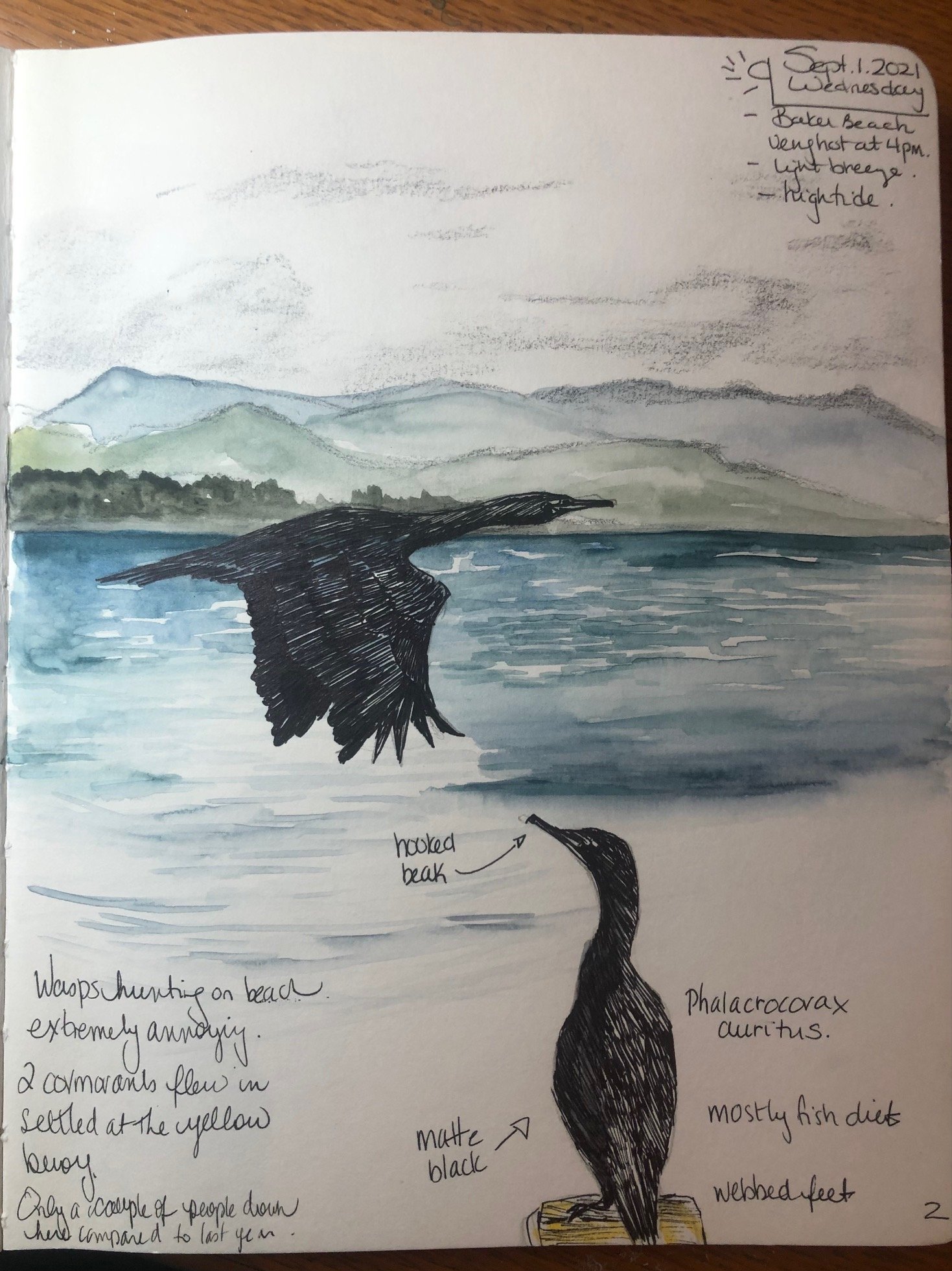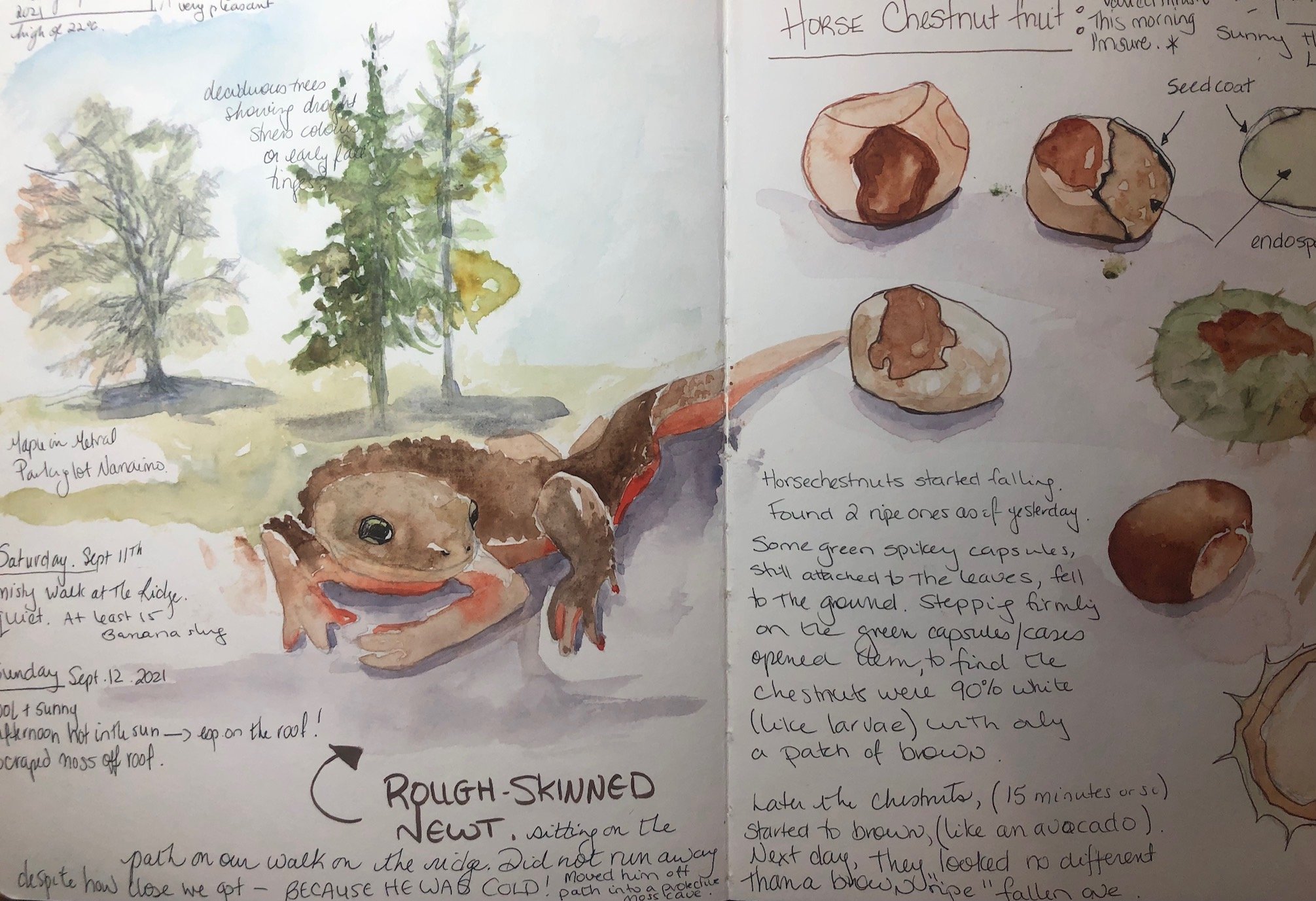This is a very sturdy fruiting body. It does indeed feel tough, like the guidebook says, and even after weeks, it keeps its form and shape, without going mushy or disintegrating. We only saw one last year in the area, but maybe this is the year for Jahnoporus hirtus because I think we have seen three now; one very much eaten.
International Fungi and Fibre Symposium
International Fungi and Fibre Symposium
International Fungi and Fibre Symposium… yes… all things fungi! It was five days of workshops and fun: cooking with fungi, dying, weaving, forays and forages, making felted hats, marbling paper with fungi that fluoresces under a blue light, and botanical dying silk scarves to name a few of the classes offered.
So why the sheep? Well, it is also about the fibre arts and one can’t pass over going to a meadery and farm to see these wonderful sheep. Soay sheep are an ancient breed and some farmers are taking pains to keep that lineage thriving. From the Wilderbee website:
Soay are the UK's oldest surviving livestock breed. They are designated At Risk, meaning there are less than 1500 known breeding ewes in the world. Breeders register sheep with the UK's Rare Breed Survival Trust (RBST), and genetics are recorded in an extensive database.
Unfortunately, we had a very dry season here in the Pacific Northwest (not as horrific as the Heat Dome of last summer, but yes, months without rain) and there were few fungi to be found. I did find this Plums and Custard fungi which was a first for me and which I had only read about in field guides. So that was a very nice forest surprise.
Western Conifer Seed Bug
Cormorants
Wireweed seaweed and notes
Hail Diagram
Winter Light in the Woods
Some September Observations
Jumpers
Jumping spiders make me clap my hands with joy. That’s all that needs to be said, really. JOY.
An assortment of things seen...
A raven feather; found near the home of the raven family nearby.
Twinflowers; a most delicate rambling flower with an incredible fragrance… for me, it is like smelling those tiny wild strawberries warming in the sunshine plus a dash of jasmine.
White flower Rein Orchid - a bit uncommon around here apparently and indeed, there was only one to be admired in the 7km walk. “Platanthera ephemerantha is considered vulnerable and is threatened by development and lumbering in North America.” - northamericanorchidcenter.org
Lumbering? As in lumbering humans on the path? Or perhaps logging? Or perhaps lumbering humans logging?
Barred Owl youngster
Melting in the Heat
Very, very hot here this weekend, what the media is calling a “Heat-dome”. Even the owl youngsters have the right idea, cooling their feet in the song bird bath.
More scoping-sketches
The juvenile bald eagles were, at low tide, giving it a go with the crabs. It was high entertainment, even if they really never held still for a good sketch moment. Even when their bodies are still, their heads are moving every 2 seconds or so.
I know it is not just sketching through the scope but the ability to hold what you see in your memory for just a moment, enough to get it on paper. I don’t have that memory muscle. Right now it is, make a line, look, make a line, look and so on. The ability to see the gestalt of the bird and get it down… one can dream.
Common Mergs
Swainson's Thrush (russet-backed)
Heard the song of the russet-backed Swainson’s last evening. Such a sound. Quintessential Pacific Northwest. As described in every guide book; hiding (check) in the forest of mixed conifers of Douglas-fir, red cedar and hemlock (check) in an overcast-ish atmosphere (check).
These are 3-min sketches. (I reckon if I draw it, I will be ready to not confuse it for the Hermit Thrush). I doubt that I will ever see this feathered vintage-sounding musical box but I will be ready for the whirl of excitement if it should ever happen.
*Saw the Swainson’s Thrush three. days. later. I feel a practical joke afoot. (And yes, it was exciting.)
Garter Snake & Bumble Bees
Unfortunately, this injured snake found on the road did not make it. With the cooler weather, they tend to sun bathe on the road. This one wasn’t squashed but it did have a hole in its neck. Bird? An injury that seemed small to us, but obviously fatal to the snake.
Puff.. puff... puffins...
If you don’t know where to concentrate your pent-up puffin love, do go to the live puffin web cam and make lots of happy noises. These sketches are of Millie and/or Willie. They are incubating (so makes for easier live sketching, especially the snooze mode). The history of how the puffins came to be back where they are is an optimistic read, basically thanks to one man who went out and got the project going: Stephen Kress.
3 Minute Nuthatches
These little sketches are a timed 3-minute fun practice. Find some photos and set your timer and go. Come to think of it, they aren’t 3 minutes really. After all 10 were done, I added the watercolour washes (quickly). The graphite was really smearing and adding a light wash stops the graphite from THE SMUDGE. So… 30 minutes plus a final 8? The practice helps when you are out in the field-, in the oh-so-big-live world, as it helps get your eye in and one feels less flustered with all the flitty, acrobatic movements that happen in real life. (Bless the Heron for its still posture.)
Sapsuckers
The little sapsuckers frequent the yard; their favourite trees are the old birches.
Sketchbook Thoughts
It is nice to have the same sketchbook on the shelf, but it isn’t important. I think finding paper that works well enough in a sketchbook format is key. So far I’ve been enjoying the Stillman & Birn Delta Series in softcover. It takes a light wash and has a nice ivory tint which is great for bright outdoor days. I had a hardcover S&B some time ago, but it is a little too heavy for my backpack. The soft-covers are sturdy enough to endure being rummaged through repeatedly. I am down to my last few pages in this book, hopefully my order has come in at the local art store.


























